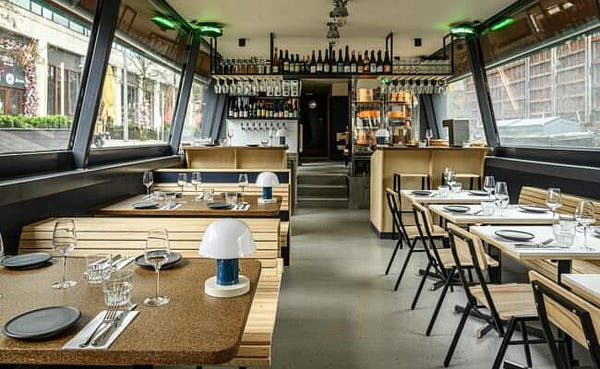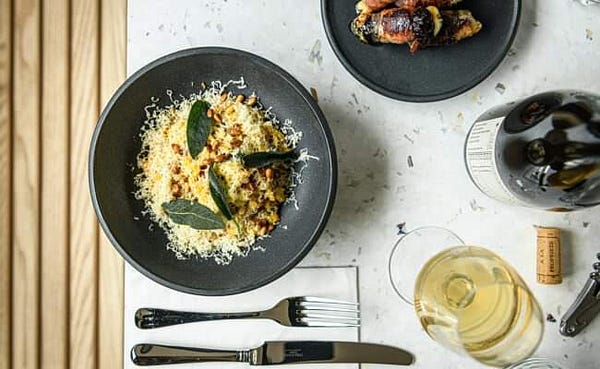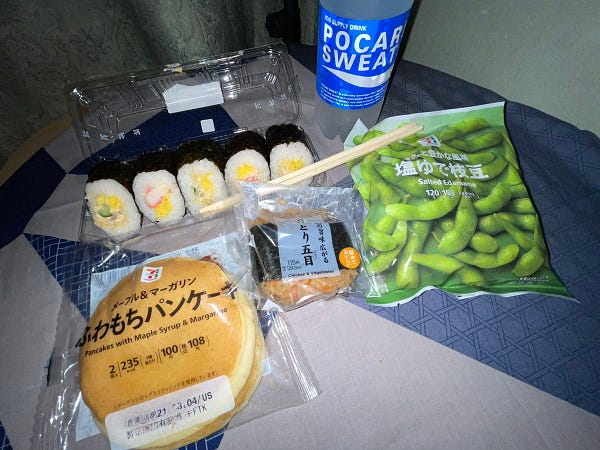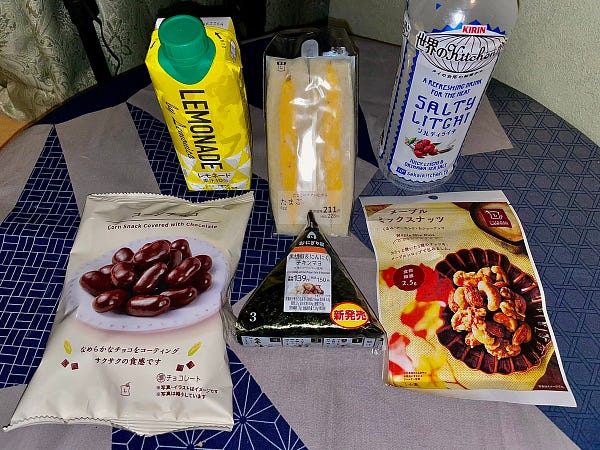Twice a month, Sunshine + Microbes sends out our full newsletter. During the weeks in between, we’ll share threads, interviews, kitchen tips, and a grab bag of our favorite things we like from the world of food and environment. Enjoy these Small Bites!
If someone shared this newsletter with you, subscribe here:
Send in your comments, mailbag questions, recipe mishaps, or cooking tips: sunshineandmicrobes@gmail.com. Also follow us on Instagram. Visit our website and cook yourself something nice.
Things We Like...
1️⃣ Michael Pollan’s coffee meditation — ‘is it time to give up caffeine?”
Jackie and I cannot even fathom what cocaine must be like because we can barely handle a cup-a-joe. Honestly it makes me feel like I’m missing out on the exciting world of coffee culture. I want to appreciate whole beans from Colombia, and sip on drinks with enigmatic names like flat white.
Still, one mug of java and I start talking a mile-a-minute and thinking I could run a mile a minute. I’m wary of drinking any caffeine (even green tea) after 1 p.m. else I’ll be lucky to fall asleep before 3 in the morning. Occasionally, I’ll have an iced latte if I’m feeling particularly exhausted. And I frequently do feel exhausted, which makes caffeine all the more alluring.
Food writer Michael Pollan recently re-published an essay in The Guardian that has me grateful that I’m incapable of developing a coffee addiction. Caffeine supremely fucks with our sleep, creating a vicious cycle for most drinkers:
Caffeine is not the sole cause of our sleep crisis; screens, alcohol (which is as hard on REM sleep as caffeine is on deep sleep), pharmaceuticals, work schedules, noise and light pollution, and anxiety can all play a role in undermining both the duration and quality of our sleep. But here’s what’s uniquely insidious about caffeine: the drug is not only a leading cause of our sleep deprivation; it is also the principal tool we rely on to remedy the problem. Most of the caffeine consumed today is being used to compensate for the lousy sleep that caffeine causes – which means that caffeine is helping to hide from our awareness the very problem that caffeine creates.
The issue with caffeine boils down to how it interferes with sleep. Pollan cites researchers that suggest “ insufficient sleep may be a key factor in the development of Alzheimer’s disease, arteriosclerosis, stroke, heart failure, depression, anxiety, suicide and obesity” and overall may shorten one’s lifespan. He also argues that caffeine can blunt creative thinking since the energy it gives us can increase “the focused, linear, abstract and efficient cognitive processing more closely associated with mental work than play.”
In fact, Pollan posits that coffee coincides with the rise of capitalism. Coffeehouses first sprung up in the Arab world, in the mid-to-late 1500s. The caffeine found inside these early cafes seemingly led to an Islamic society that was “in many respects more advanced than Europe, in science and technology, and in learning.” Those Arab and Turkish style coffeehouses made their way to Europe in the decades that followed. Coffee was a revelation, but changed the way people lived by keeping us alert and awake and *sigh* ...ready to work.
Centuries later maybe it’s time to reexamine what’s in that cup of cold brew or cappuccino. Pollan — an admitted coffee obsessive — tested it out for himself by going 30 days without caffeine. The withdrawal was not easy. He felt sluggish, unfocused. And relieved when he could return to enjoying his morning cup.
Even I cannot imagine myself giving up caffeine completely, but I do want to be more conscious about when I drink it. Sure, caffeine might not be cocaine. Nevertheless, it’s worth acknowledging how powerful and addictive of a drug it truly is.
abrazos,
Matt
Do your friends already subscribe to Sunshine + Microbes? If not, have them try something new!
Four More Things We Like This Week
2️⃣ The Chromatic Diet
My friend Esmeralda mentioned this important piece of food/art history to me this week. French photographer and installation artist Sophie Calle’s 1997 photo series “The Chromatic Diet” documents the meals of a fictitious alter ego named Maria, who insisted that everything she ate fit into a strict one-color scheme. This rather whimsical work has had a clear impact on contemporary food photography:
Quite simply, it’s a study of color in the form of food. The monochrome sea also forces attention to the geometry of each shot, balanced with the [utmost] care. It may seem counterintuitive, but the presentation and emphasis on the core elements of design make dishes as boring as an unseasoned flounder filet on a bed of white rice-something worth focusing on.
Check out some of the photos and menus from the series here.
Perhaps I’ll follow the lead of writer Emma Orlow and eat a chromatic diet for a week myself!
-Jackie
3️⃣ Cheese Barge 🧀 🛥️ 🧀
The idea of going out on a boat doesn’t really excite me. But a cheese barge — well aye aye captain! The Cheese Barge, a new restaurant that floats alongside a London dock, serves an entire menu based around British cheeses. (“A barge de fromage,” quips The Guardian’s Grace Dent)
The 96-foot long double-decker boat offers dishes complete with many of the local cheeses available in the region, such as Ogleshield, a raclette-style cheese made at the dairy Jackie used to work for in London. Menu items range from grilled cheese sandwiches to fried curds and honey to devils on horseback (prunes stuffed with bleu cheese and wrapped in bacon).




Featured cheesy desserts include mascarpone pudding and a Yorkshire Curd Tart. Braver patrons can order a four-course meal centered on the versatile fermented food. Or just order a cheese board and sip wine on the vessel’s upper deck.
Any cheese aficionados probably have their mouths watering reading about this floating cheese-topia. Owner Mathew Carver understands. The Cheese Barge follows previous ventures like The Cheese Bar restaurant and food truck and a conveyor-belt diner called Pick & Cheese. Who knows what’s next? It sure sucks that the moon isn’t made out of cheese, but maybe Carver has an idea for fixing that problem.
-Matt
4️⃣ Pandemic Baker’s Are Going Pro
This New York Times piece spotlight’s some of the bakers that have turned their hobby into a professional during the pandemic. Max Kumanagi was looking for a way to keep busy while laid off from his job singing and dancing in “Jagged Little Pill” on Broadway. Like so many, he turned to sourdough. He and his partner now run Humpday Dough, producing beautiful loaves in their Harlem apartment and delivering across the city.
Cottage bakeries have exploded, as have applications to professional baking and pastry programs at culinary schools. Penny Stankiewicz, a pastry and baking instructor at the Institute of Culinary Education, completely understands the appeal, declaring at the start of the pandemic “we were all so unstable in our core and we couldn’t really rely on anything, we had this thing we could nurture.”
-Jackie
5️⃣ Conbinis are Pure Gold at the Olympics 🎌
One winner at these strange Olympics are conbinis, a 24-hour convenience store in Tokyo that truly offers everything. Conbini culture, which has incorporated chains like 7-Eleven, has been a hit for media and athletes alike. Due to the pandemic, the Olympics created a bubble that limits where visitors can go outside of the venue. As a result, conbinis are a godsend.
Andrew Keh writes in the NY Times that “a conbini contains a culinary world unto itself, a bounty of bento boxes, fried meats, sushi, noodles galore and all manner of elaborate plastic-wrapped meals and rare snacks.” The stores are a ritual of travel in Japan, thanks to their variety and ubiquity. There’s even a popular podcast called Conbini Boys, hosted by two expat Americans.
Here’s a rundown of some of the great finds that guests at the Tokyo Olympics have found at conbinis:
Keh: “I have plucked from conbini shelves that sparked at least a basic level of pleasure, and often much more: a runny boiled egg; mapo tofu (the spicy Chinese staple); French fries; a cup of cold corn soup (which I sipped through a straw); an unnaturally shaped, suspiciously juicy disc of fried chicken; lu rou fan (Taiwanese braised pork); Okinawa-style pig ears; hiyayakko (a cold tofu dish); soboro don (ground beef and egg over rice); spicy grilled chicken cartilage; a tuna salad sandwich; an egg salad sandwich; tonkatsu (breaded pork cutlet, which in this case came with a side of spaghetti); a hunk of salmon.”
dress shirt and necktie; or underwear
Keh again: “a corn dog I bought at 7-Eleven came with a sauce packet designed so that a single pinch sent ketchup and whole-grain mustard shooting simultaneously from a spout, like two synchronized divers”
cold soba noodles with tsuyu sauce, scallions, wasabi, frothy grated yam, a gooey egg
old pack of grilled chicken gizzards
vinegar-flavored squid legs
crushed-almond Pocky sticks
Japanese plum wine (among a broad alcohol selection)
Premium Gold matcha ice cream
peanut butter cream sandwich
drinkable cheese tarts




Sources: NY Times’ Tokyo Convenience Store Chicken Gizzards Saved My Life and South China Morning Post’s For foreigners covering the Games, Japan’s ‘konbini’ are love at first bite and Devin Heroux’s Twitter account.
-Matt
----------------------------------------------------------------------------------------
Sunshine + Microbes team
Jackie Vitale is a cook and kitchen educator based in Stuart, Fla . She runs Otto’s Bread Club and is co-founder of the Florida Ferment Fest. Her newsletter explores the intersection of food, culture, environment and community.
Matt Levin is a communications strategist at the ACLU of Texas. He edits Sunshine + Microbes and contributes other scraps to each issue.









